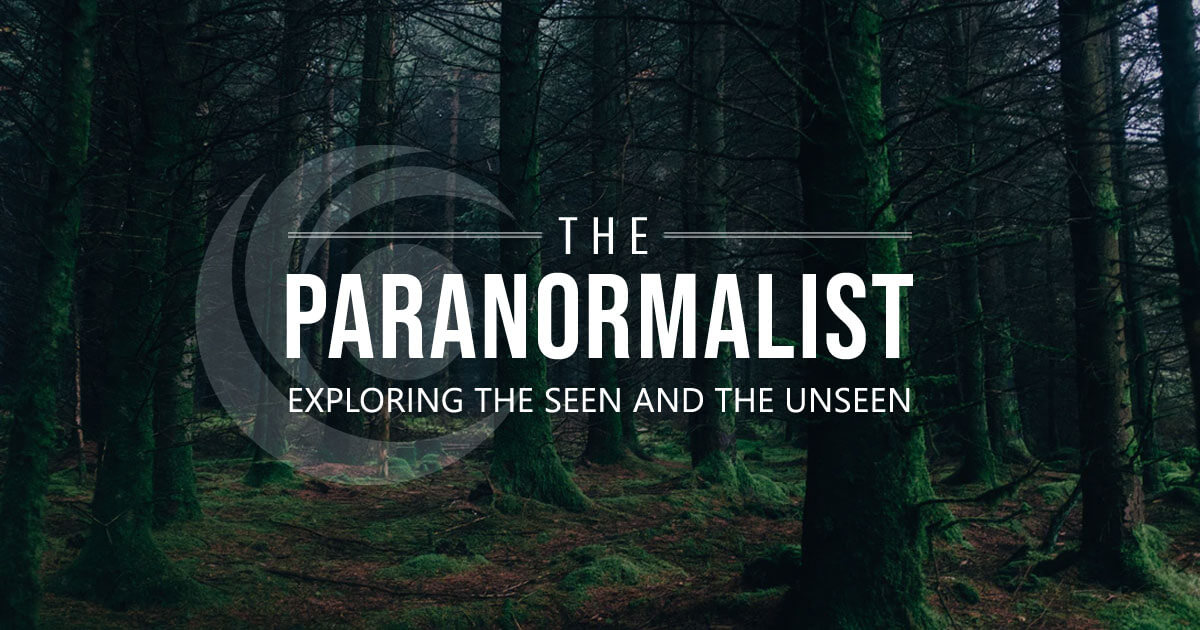John’s Bad Attitude
Before going further into my account of the events in southern Oregon, I would like to backtrack a bit to discuss my general frame of mind as I embarked on my inaugural excursion into Bigfootdom.
Like all things strange and unknown, I’ve had a lifelong interest in stories of Bigfoot, Sasquatch, the Yeti, and other such mysterious hominoids and proto-humans. However, I was not and am not part of the “Bigfoot Community” and had no real expertise or standing in that field of research. And while I was very much interested in learning more about the subject and about Adam’s research methods, I had no actual expectation of “finding Bigfoot” on our little expedition out West.
I was simply looking forward to spending some time with my friend Adam, visiting a part of the USA where I had never before been, and hiking and camping in the great outdoors. Bigfoot or any other sort of strangeness was not something to which I had given much consideration. My attitude was, if we were to see some evidence of the existence of these creatures, then that would be wonderful. But if nothing of the sort happened, I was perfectly fine with that.
To be completely honest, I only wanted to get away from my problems for a while. I was having a very bad month…or year — well, a couple of years. Several deeply troubling and disappointing personal issues had recently come to a head and I was quite upset and rather bitter. Despite my excitement and eagerness at the prospect of my upcoming travels, I could not entirely rid myself of the troubling thoughts that crept into my mind. It was in this negative frame of mind that I embarked on this journey.
I bring up my negative state of mind because I have considered that it might have had some influence or bearing on the events that followed in Oregon. This is only a hypothesis and I have no way of proving it to be true or untrue, but I have entertained the possibility. Moving along…
“Dr. J” and the Southern Oregon Habituation Area (SOHA)
The other researcher that Adam had arranged to meet was Dr. Matthew Johnson, who is often referred to as “Dr. J” in Bigfoot circles. He is a doctor of psychology who became extremely interested in the subject of Bigfoot after having a frightening experience with his family a decade or so earlier while hiking near the Oregon Caves National Preserve. Before leaving for our journey out West I viewed a video of Dr. J’s accounting of this experience to a local news station. In it, he became visibly emotional as he retold the details of the event. I know very well that encounters with the unknown are often traumatic and I fully understood and empathized with his reaction.
From what I gathered, prior to this incident, Dr. Johnson had little interest in the subject of Bigfoot but afterward felt compelled to gather evidence of its existence. This appears to be a fairly common reaction. While some people want nothing more than to never have such an encounter again, others become obsessed with repeating the experience and/or collecting evidence of the reality of these beings. Dr. Johnson unquestionably falls into the latter camp.
On Sunday, June 8, 2014, after two days and nights at the Olympic Project in Port Angeles, Washington, Adam and I drove our rental vehicle to the home of Dr. Johnson and his fiancée Cynthia in Puyallup, a suburb of Seattle. Our plan was to spend the night at their home and leave the next morning at first light for Dr. J’s habituation area in southern Oregon, eight hours south.
Dr. J had been frequenting this place, which he named the Southern Oregon Habituation Area, or SOHA, every two or three weekends for nine years. In his communications with Adam, he shared quite a few audio recordings of what he felt were various vocalizations and Bigfoot-speak, some of the utterances sounding plainly like English words. In the course of listening to these recordings, Adam heard a specific howl or growl that sounded precisely like one that he had heard while in the Cascade Mountains of Washington in August of 2012. This was the primary reason for Adam’s desire to visit SOHA.
The Johnson-Carlson Interview
Prior to embarking on our northwestern adventure, Adam advised me that I would need to call Dr. Matthew Johnson and have a “brief, friendly chat with him” (as I believe he phrased it). Dr. Johnson, he told me, was somewhat guarded about whom he allows to visit his research area and only wanted to meet by telephone so as to be comfortable in having me there. Merely a formality, Adam framed it. In actuality, it was an intense, ninety-minute interview for which I felt woefully unprepared. I knew of Dr. Johnson, but not much about him or the details of his research. I wished I had studied prior to our talk and I felt foolish when I was unable to describe much about his findings at SOHA. I was at fault for not doing my homework prior to the conversation.
Dr. Johnson, I learned, preferred to call Bigfoot “Forest People” and felt that they had supernormal or paraphysical abilities including mental telepathy and the ability to become invisible at will – in other words, Dr. Johnson fell into the “Woo-woo” camp of Bigfoot researchers (see my previous article for more about this). Having no preconceived ideas about the nature of these beings, this was perfectly fine with me and I said as much to him. What I believe Dr. Johnson wanted most to discern was whether or not I was open-minded. He simply did not want to allow a scoffer and skeptic to join them at SOHA. That felt perfectly reasonable to me.
The other subject that he emphasized was The Rules to be followed while at his habituation area. Dr. Johnson has a strict set of rules and protocols that he adheres to while at his habituation area and he insists that those who accompany him also adhere to them. Don’t agree to the rules, you don’t go. Break the rules, you get kicked out. I understood and agreed to comply. At the end of 90 minutes or so, Dr. Johnson paused and said, “You may join us at SOHA.” I was both relieved and exhausted.
“Brief friendly chat, huh?” I said to Adam as I described the grueling interview. He only laughed heartily. Typical Adam!
From Puyallup to SOHA
We were greeted warmly by Dr. Johnson and Cynthia and my initial impression of them was positive. Dr. J is a big guy, to say the least. He’s a former college basketball player and stands six-feet nine-inches (206 cm) in height and probably weighs a good 280 pounds (127 kg). His size notwithstanding, I found him to be friendly and sincere, and not at all intimidating. His fiancée Cynthia was very sweet but when discussing their research at SOHA was similarly earnest and intense. She was clearly an enthusiastic supporter of Johnson’s work, as well as a participant in it.
After treating us to a lovely home-cooked dinner in which we were each served a steak approximately the size of a toilet seat, we adjourned to The Johnson’s living room to further discuss our plans. We were also asked to sign nondisclosure documents in which we agreed, among other things, to refrain from visiting the Southern Oregon Habituation Area without express permission by Dr. Johnson and only to enter SOHA if accompanied by Dr. J. Truthfully, I don’t know if these documents were legally binding. The area is on public land and not owned by Dr. Johnson. Nevertheless, both Adam and I signed without hesitation.
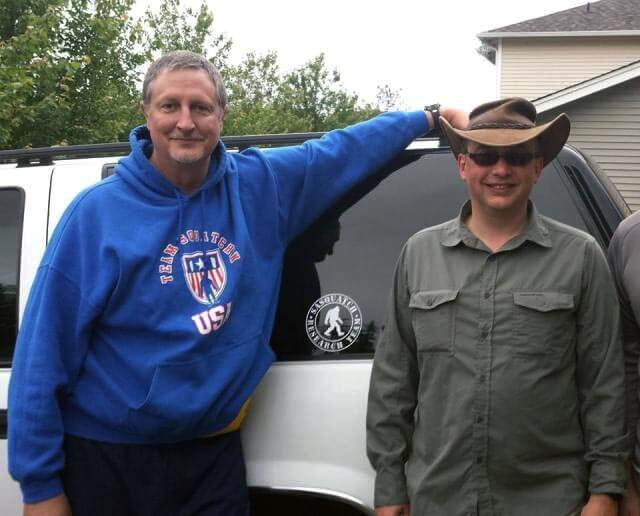
We were in bed early that night and up early the following morning, on the road by six a.m. We had a long ride ahead, a solid eight hours south from Puyallup, WA to Grants Pass, OR, where the habituation area was located. Fortunately, we were able to take one car, Dr. J’s big old white Ford Suburban. Adam sat in the front passenger seat, accompanied by Matt’s toy fox terrier, Atlas. Atlas had taken a liking to Adam and spent much of the time at his side or on his lap. I sat in the back seat, passenger-side, surrounded by camping gear and supplies to my left and behind me. We both slept off and on for much of the drive, content to let Matt drive.
During those times when we were awake, Dr. J took the opportunity to further expound on his beliefs regarding Bigfoot research methods. For quite a long time, Johnson explained, he followed the standard protocols for gathering evidence of Bigfoot. These include searching for hair samples for DNA analysis, looking for footprints, casting them in plaster, and analyzing them, and (hopefully) getting photographic or video evidence of the creatures. And, of course, to gather an actual specimen, dead or alive, or skeletal remains is always the ultimate hope for any Bigfoot researcher: definitive proof.
The Habituation Method
Somewhere along the way, (forgive me for not recalling the precise details) another researcher who was a strong advocate for the habituation method of study and investigation of Bigfoot, convinced Dr. Johnson that he had been going about his research all wrong and that he should try employing his research methods. Bigfoot, he explained, were far too intelligent – and may even possess psychic abilities – and therefore can easily avoid being captured alive (or dead), and only very rarely on camera or video.
The crux of the habituation method of Bigfoot research, as I understand it, consists of:
- Visiting the same area regularly, so that the Sasquatch/Bigfoot in the area become accustomed to your presence.
- Attempting to communicate with these beings in a non-threatening manner.
- Gaining their trust slowly over a period of time with the goal of eventual open communication and interaction.
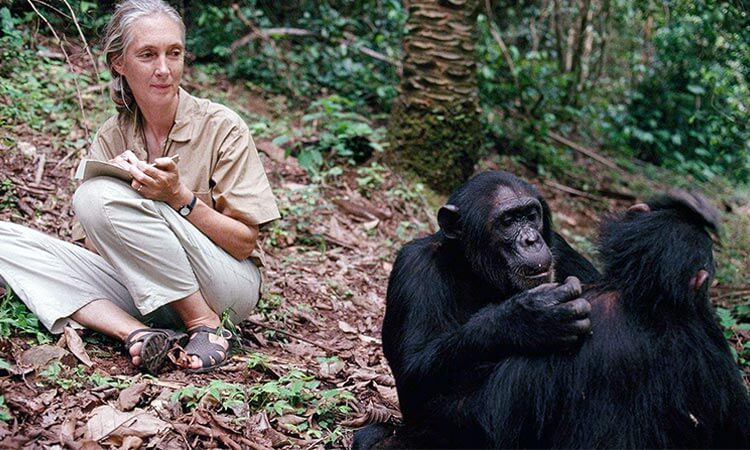
The works of Jane Goodall and her chimps and Dian Fossey and her gorillas might be analogous to the Bigfoot habituation method. The general idea being, make these creatures accustomed to your presence, gain their trust, draw them in, and then interact and communicate with them once trust is gained. If these Forest People were wary of human beings and as intelligent and psychically intuitive as Dr. Johnson claimed, then this methodology seemed a reasonable and intelligent way of doing things. It made sense to me, at least.
Having become an enthusiastic proponent of the Habituation Method, Dr. Johnson appeared equally passionate in his opposition to the traditional methods that he himself once employed. Camera traps, tramping through the brush at night with infrared cameras and night-vision goggles was, in his opinion, a waste of time. Johnson felt that those methods were a surefire way to frighten off the wary and intelligent Forest People, and were entirely counterproductive.
We continued to chat as we drove south, Adam and I doing more of the listening than talking. I learned that the disdain I heard while at the Olympic Project for Dr. Johnson, his beliefs and methods, and in general for the “woo-woo” crowd was most definitely reciprocated. Dr. J had little regard or patience for the researchers known as “apers”, those who believe that these creatures are no more than an undiscovered species of bipedal ape or a relict hominoid. As an outsider, I found this glimpse into these competing ideologies of Bigfootdom quite fascinating.
Also, I gathered that the collecting of physical evidence of Bigfoot was a secondary consideration for Dr. Johnson at this stage in his research. His main goal seemed to be in gaining the trust of the Forest People to the point where they would willingly enter his encampment and dialogue openly with him. After so many years of consistent visits to the habituation area, he felt that he was making steady progress towards this end. He further claimed that the Forest People had made contact with him through mental telepathy or mind-speak. I was becoming very eager to see what Dr. J had going on at this place in southern Oregon.
Arriving at SOHA
Eventually, we arrived in Grants Pass, a pretty little town roughly 70 miles north of the California border and about 30 miles from where Matt Johnson had his seminal Bigfoot experience near the Oregon Caves. After passing through the main part of Grants Pass we found ourselves on some side roads on the outskirts of town that eventually led to some unpaved back roads.
One of these backwoods country lanes took us to the entrance to SOHA, an abandoned logging road – and I use the word “road” loosely – that climbs eleven miles up the spine of a mountain ridge. At the very end of the of that eleven miles, it dead-ends high on the mountain ridgeline. This is where Dr. J made his SOHA encampment.
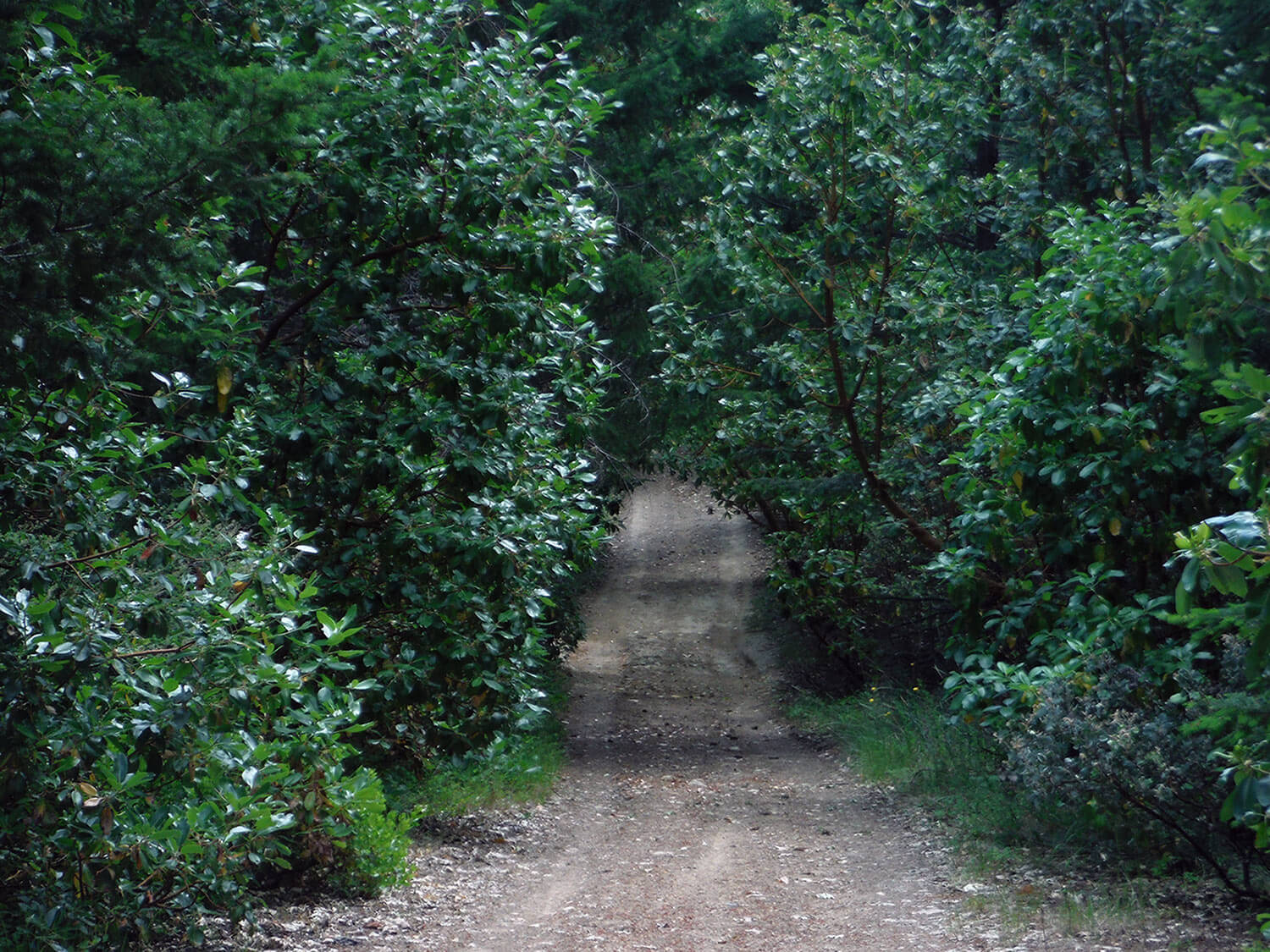
The old timber lane had deep ruts and pits throughout, necessitating some careful weaving of his Ford Suburban by Dr. J to avoid the deepest of them. Blowing out an axle up there would be a difficult situation. Slowly and steadily we climbed and for much of the ride, the passenger-side tires were within only a few feet from the edge of the ridge, which fell away steeply on our right.
The brush on either side gradually became so dense that it encroached on the road, making it seem at times like we were driving through a green tunnel of vegetation. At this point, Matt and Adam pulled in the collapsible side-view mirrors so that they would not be torn off by the branches, which scraped and clawed at the side of the Suburban. I was grateful that we didn’t drive our rental car up there. No doubt we would have been hit with a stiff penalty for returning it horribly scratched.
The SOHA road finally ended in what was just about a perfect circle, a turnaround area for vehicles. Dr. J parked his SUV to the right of the entrance near the edge of the circle. There was nothing other than tall trees and dense areas of brush surrounding us and no homes, other vehicles, or campers were anywhere in the vicinity. We were utterly alone and isolated at the end of that long road high on that mountain ridge.
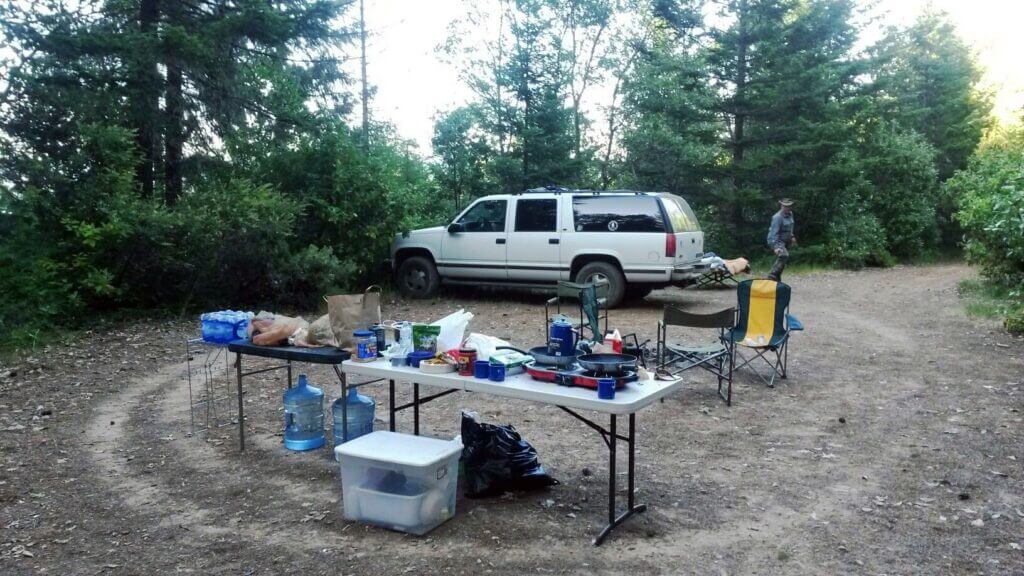
The area was rather beautiful in a lonely way, as forests are, but Adam and I both later remarked that we felt a very distinct sensation upon our arrival and throughout our time at SOHA. It was a heavy, oppressive feeling, a feeling of watchfulness. This was not something, Adam later told me, that he had felt before. Having spent an enormous amount of time in forests and wilderness areas throughout the world, this was an unfamiliar sensation to him. I am far less well-traveled than Adam, but I have done a fair amount of camping in forests and have also never experienced this before.
We unpacked our gear from the back of Dr. J’s Suburban and set up camp over the next hour, including opening the cots that Dr. Johnson had provided for us. One of The Rules of SOHA was that we must sleep outdoors, not in tents or in the vehicle. The Forest People, we were told, prefer us to sleep outdoors and would ping our tents or the Suburban with stones if we sleep inside them. Adam and I did not argue this point or any other of Dr. J’s rules and we followed his instructions unquestioningly.
Gifting bowls and tree structures
We also set up a large folding table near-opposite of the entrance. Here, we would keep some of our supplies for easy access and Dr. Johnson would be able to sit and prepare his “gifting bowls”, which were large, stainless-steel dog food bowls in which Dr. J placed various foodstuffs as an offering for the Forest People.
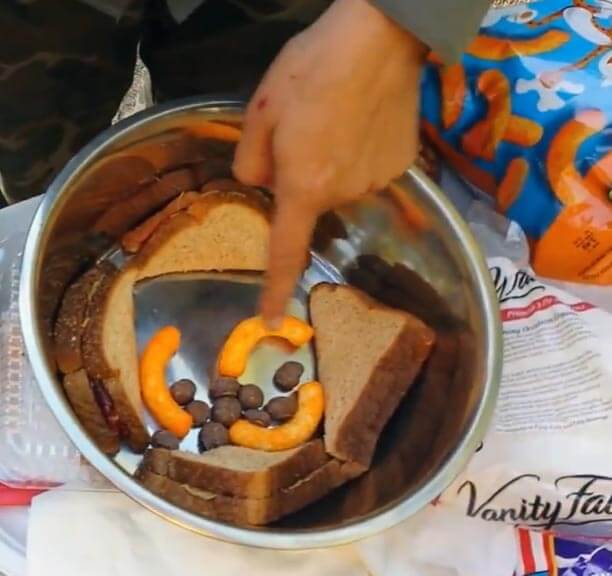
Once our camp was set up, Dr. J did just that, sitting on his camping chair at the long folding table and meticulously cutting, preparing, and placing these foods into two bowls. One bowl was filled mostly with fruits and vegetables, while the other was filled mostly with breadstuff and sweets – fig newtons, sticky buns, and peanut butter and jelly sandwiches that Dr. J made and cut into small triangular pieces.
After the bowls had been filled, Dr. Johnson carried them into the woods a short ways from the camp. He was insistent on having us watch him prepare the gifting bowls and he wore rubber gloves while handling these stainless-steel receptacles, so as to avoid leaving his fingerprints on their sides. The plan was to check the bowls the next morning to see if anything was taken. This ritual was repeated each of the four days that we camped at SOHA.
Taking the narrow footpath at the twelve o’clock position of the circle, we wound our way through the woods to the area where Dr. Johnson leaves his gifting bowls. He leaves them in the same place each time, consistency being important, he explained. He went on to say that one time, he decided to move the bowls closer toward the edge of the camp and the Forest People did not approach his camp for long afterward.
The gifting place was a couple of hundred feet or more from the perimeter of the circle. As we walked through the woods Dr. J showed us some tree structures, a phenomenon often associated with Bigfoot activity. These were sizeable tree branches and saplings which were bent and twisted in such a way that would be exceedingly difficult or impossible for a human being to achieve manually. Of course, this might have been caused naturally by a wind storm, but the manner in which these branches were twisted was highly unusual. It was quite strange and the photo below does not fully do it justice.
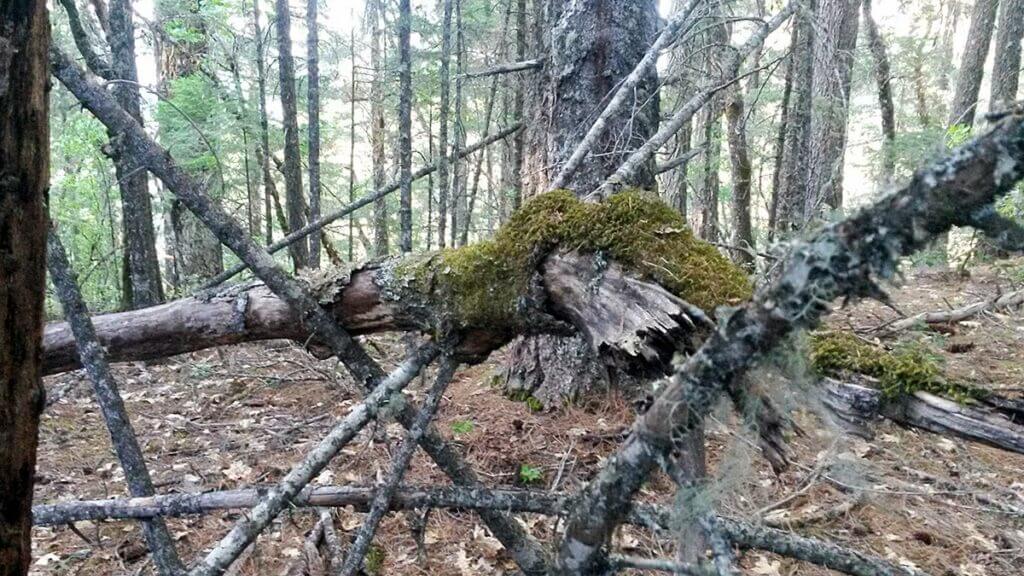
Night One at SOHA
After setting up camp, leaving the gifting bowls, and having an early evening meal, we had some time to relax and talk before dark. Dr. Johnson explained to us that the first night was usually quiet. The Forest People, he said, would be wary of unfamiliar people and watching us quietly from a distance. We were told that we should not expect much interaction on night one.
This proved to be true. Nothing much happened on that first night. We did not see anything and heard nothing more than the steady breeze sighing through the trees. Another of Dr. Johnson’s Rules was that there were to be no fires and no flashlights, both of which he felt would drive off the Bigfoot. So once nightfall had come, we stood there in the darkness with only the moonlight illuminating the area.
Also, if we heard a sound or saw something we were not to extend an arm and point with our finger. Dr. Johnson felt that this could be construed by the Forest People as a sign of aggression. Because the camp was circular, we were to use points of a clock: the six o’clock position is the entrance to the camping area; straight ahead from the six o’clock position was the twelve o’clock position; facing the twelve o’clock point, the left was the nine o’clock position, and to the right, the three o’clock point. And all points in between the twelve, three, six, and nine o’clock positions were easy to determine. So, if we were to hear or see something, we would just call out, for example, “Two o’clock!” Simple enough.
Talking to trees, singing to shrubs
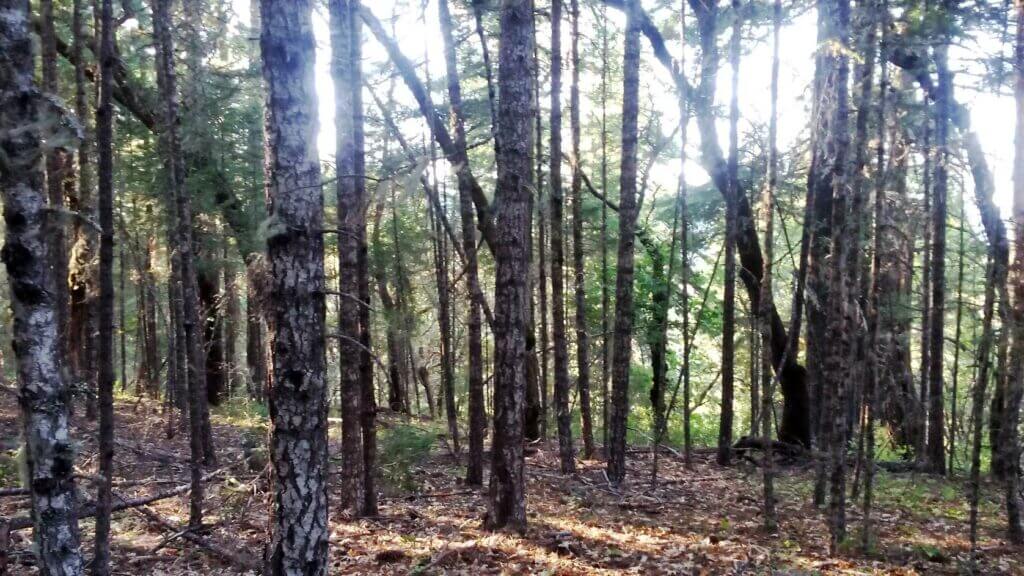
Once night had fallen, Dr. Johnson told us that we should take turns walking around the perimeter of the camp circle and call out to the Forest People, introducing ourselves by name. Adam and I dutifully followed Dr. J’s instructions, approaching the surrounding trees and shrubs and calling out into the darkness, “I am Adam. My name is Adam. Nice to meet you!”, and “I am John. My name is John. Hello! Thank you for having us here!” – and so forth. I felt a bit self-conscious and silly, but I think Adam rather enjoyed it. He asked Dr. J if it would be alright if he sang them a song. Dr. J said that they like music and singing and gave Adam the go-ahead, at which point he belted out loudly into the brush Jerry Lee Lewis’s Great Balls of Fire. Classic Adam. Dr. J suggested he sing something more soothing the next time.
Dr. Johnson also had a large portable radio and played smooth jazz featuring a heavy rotation of Kenny G and his soprano saxophone. We teased Dr. J that his crap selection of music was the reason that the Forest People were hiding. He laughed. The evening went on that way, uneventfully with Adam and I gently teasing Dr. J, which, to his credit, he took good-naturedly and seemed to enjoy. He was not so serious about his work as to be unable to take a joke at his expense.
Despite our talking, singing, and music, however, the Bigfoot Forest People remained silent that evening, just as Dr. J had predicted. At around 1:30 AM we decided to turn in for the night, stretching out in our cots. The weather was perfect for sleeping – cool, but not cold, with no humidity. A steady breeze blew, but it was mostly blocked by the trees. In fact, the weather was perfect the entire time that we were in Oregon, just as it was in Washington: hot during the days but very low humidity, cool at night, and not a cloud in the sky at any point during the trip.
Night Two at SOHA

We slept well and woke up in the morning refreshed. Dr. Johnson explained to us that the Forest People are quiet during the day and more active after nightfall, so there was no reason that we had to hang around the campsite all day. He had a number of daytime excursions planned for us, all of which were very enjoyable. So, after checking the gifting bowls (which were untouched and undisturbed) Dr. J drove us to Crater Lake, about 2.5 hours away. That was a lovely trip and Crater Lake was impressive. Adam and I enjoyed viewing the countryside along the way.
Having grabbed an early, fast-food dinner, we returned to SOHA. Because we could not have a fire at SOHA, we were unable to cook, and therefore most of our meals were taken at local fast-food establishments in Grants Pass or somewhere on the road during our daytime travels. I came home a few pounds heavier as a result.
We were near the Summer Solstice and the days were long, the sun setting at about 8:50 PM. Shortly after dark on that second night, the woods surrounding our camp seemed to come alive with activity. The Forest People, it seemed, decided to get a closer look at us after their initial reluctance on Night One.
We began hearing heavy, seemingly bipedal footfalls in the dark woods to our left, or at the six o’clock to twelve o’clock positions. The woods to our left went back a fair distance before the drop-off (recall that we were on a mountain ridge), but to our right (three o’clock area) we could only hike in a few meters into the dense brush before the ridge sloped steeply downward. At the top of the circle, at the twelve o’clock position, there was more forest and a narrow footpath weaved through it and then further up the ridge from there. Noises and footfalls also emanated from this direction.
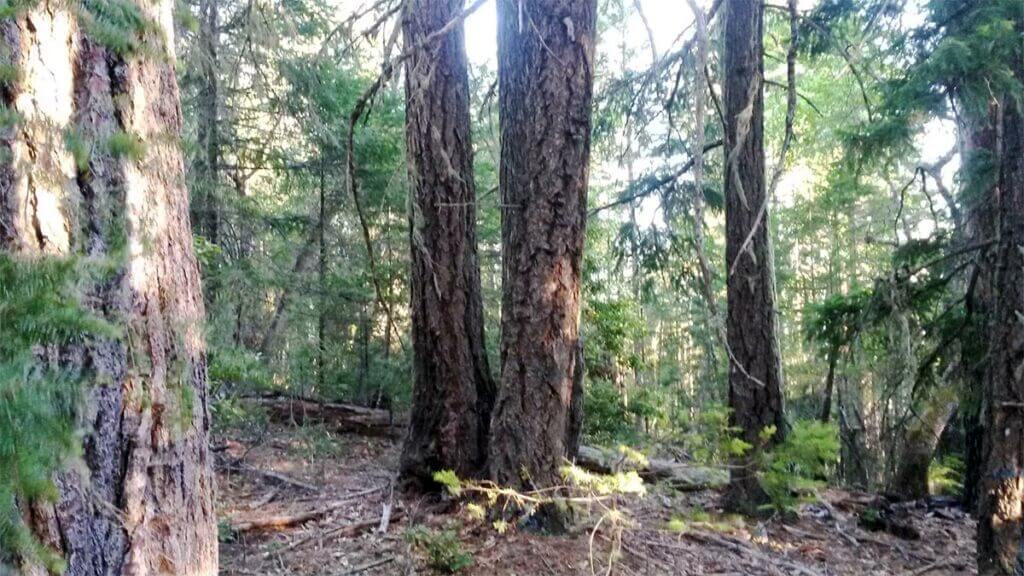
In addition to the sounds of breaking branches and heavy footfalls, we heard various unusual noises sounding like calls. We had heard nothing of the sort the night before. There was a definite sense of activity in the woods surrounding our camp circle.
The moon was waxing during our four nights at SOHA and would be full on our final night. The bright moon, clear skies, and lack of humidity illuminated the forest to some degree, although the surrounding forest was still too dark to see into it very far. As the moon climbed in the sky to our left, behind the woods in the nine o’clock area, the trees were backlit by its light. Three times I saw tall, dark, upright silhouettes moving between these trees. They were fleeting glimpses, but I felt sure of what I saw.
Interestingly, just two days before this writing, I spoke with Bigfoot researcher Dan Lindholm who lives near SOHA and has visited there on his own several times since word of this story became public. He described having this same experience exactly as I have related it here: the woods backlit by moonlight, tall, dark, silhouetted figures moving between the trees. Dan was unaware that I had seen this also, and was quite shocked and relieved when I told him that I had.
These strange incidents are often discomfiting. You question yourself, whether you actually saw what you believe you saw, perhaps you even question your own sanity. Corroboration often brings a sense of validation and relief. Having heard that Dan had this same experience, I too felt both validated and relieved.
The evening went along this way until we retired to our cots, again at around 1:30 AM. Up until that point we continued to hear vocalizations, heavy footfalls, breaking branches. An unmistakable presence of other beings – not animals, but intelligent beings – was persistent throughout. Yet, we never able to get a clear view of them, other than my few quick glimpses of those swiftly moving silhouettes.
Invisible Bigfoot??
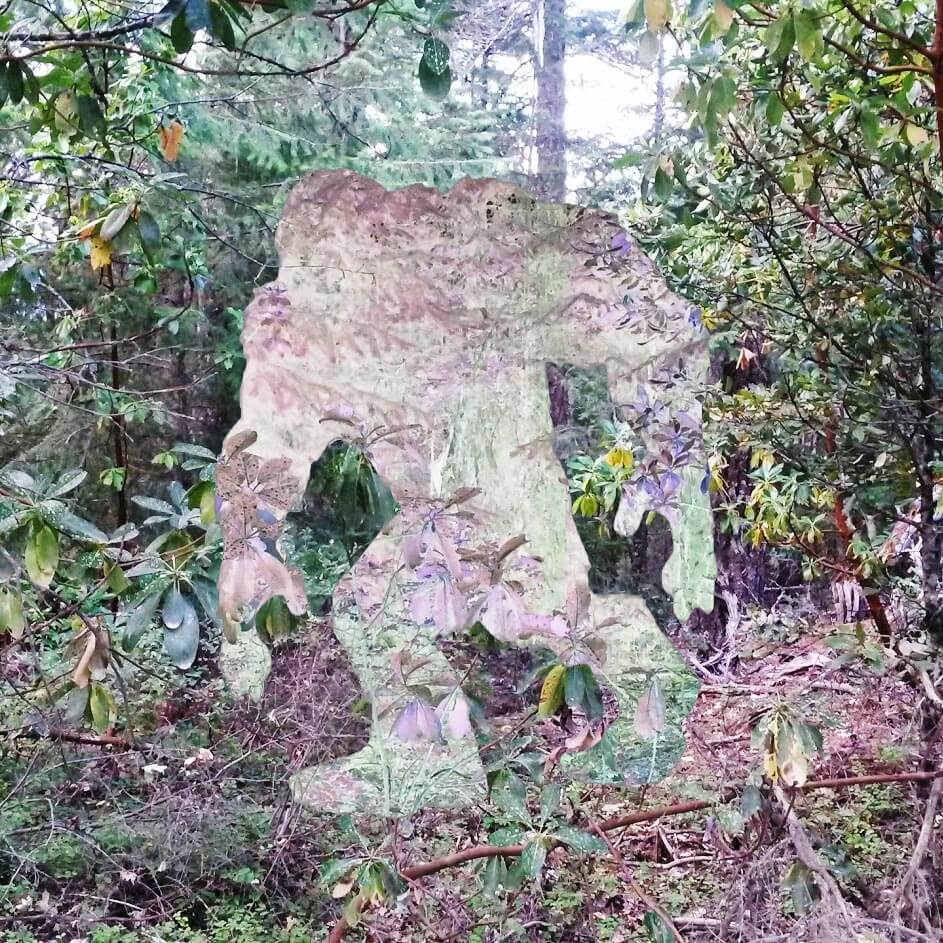
We also kept up our practice of roaming the perimeters of the camp and calling into the woods, repeating our names, and asking the Forest People to come forward and say hello. Unfortunately, the Forest People or whatever were surrounding us chose not to reveal themselves. Dr. Johnson said that they might very well have been “cloaked” or invisible. If these beings could actually do this, then that might explain why we could not see them.
The idea that Bigfoot have the ability to render themselves invisible at will was difficult for my rational mind to accept, but I was open to the possibility of it being true. After all, who was I to impose my preconceptions?
Part Three of Bigfoot, Interdimensional Portals, and Childhood Monsters is coming soon! Don’t miss it! This is where it gets really creepy!
Date/Date Range:
